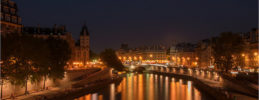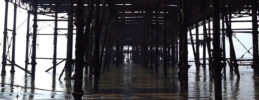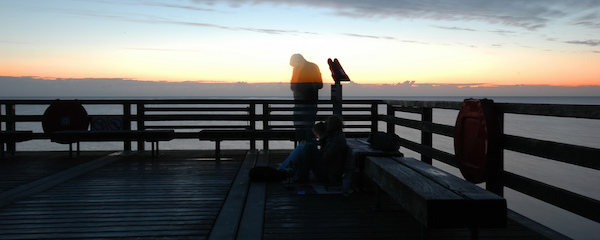
('Ghost' © Jan W, 2012)
*
HAUNTED STATE
by BRENDAN O’DEA
*
For any readers looking for variety, entertainment and the thrill of feeling slightly unsettled while tucked up in bed after a hard day at the office, I recommend Irish Ghost Stories, edited by David Stuart Davies. Nearly three decades ago, while still living in Ireland, I owned a compilation of supernatural tales that highlighted the scope of the Irish ghost story. I lost this treasured volume somewhere in transit during my nomadic existence in the UK. Finding and buying Davies’s book partly compensated for this loss.
This book interests me because I am Irish and enjoy writing ghost stories. Davies’s introduction begins:
The Irish writer is ideally suited to creating stories of strange ghostly happenings. At his best the Irish writer has a wild and fantastical imagination causing him to view life through a wonderfully strange distorting mirror. There is something dream-like and unfettered about the Irish creative force which enables these storytellers to travel down different roads from those of other authors; roads that are bizarre, challenging and eccentric in nature, allowing the Irish scribe to conjure up unexpected and often fantastic scenarios.
This may bring comfort to the Irish writer but I am unsure to what extent it reflects reality. Many British and American writers have turned out excellent supernatural fiction, including Edgar Allen Poe, Ambrose Bierce, M. R. James, E. F Benson, Edith Wharton and Susan Hill. Saying that, there is no doubt that many Irish writers and readers have embraced this subgenre.
This book showcases works of Sheridan Le Fanu, W. B. Yeats, Bram Stoker, Oscar Wilde, J. H. Riddell, Fitz-James O’Brien, Thomas Crofton Croker, Jeremiah Curtin, Daniel Corkery and Rosa Mulholland. Some of these authors belonged to the Protestant Ascendancy, the Anglican ruling elite in Ireland up until Independence. They often had one foot in Ireland and the other on the British mainland. This weakens Davies’s thesis regarding the uniqueness of the Irish or Celtic imagination, as these writers had their perspective formed in a much wider and more varied context. However, it shows the Irish ghost story was not the preserve of the Catholic, Protestant, Nationalist or Unionist, but belonged to the whole nation.
The work of Sheridan Le Fanu is given pride of place in this volume, as probably the most accomplished of the featured writers in the ghost story genre. Wilde and Yeats excelled in the areas of drama and poetry respectively, but Le Fanu focused on, and perfected, his supernatural tales. M. R. James, the renowned British writer of ghost stories, considered Le Fanu a master of suspense. My favourite Le Fanu story here is ‘Ghost Stories of Chapelizod’, with its eerie evocation of place and the people who inhabit it. It demonstrates how villages and towns have more than one story to tell. Set in Chapelizod, a town outside Dublin, Le Fanu creates a series of anecdotes, or ‘legends of terror’, such as the story of a bully who is terrorised by the ghost of one of his victims. These tales contain elements identified by M. R. James as key to the effective ghost story: having a believable, contemporary setting, and introducing a malign force into this milieu. This helps explain why James always held Le Fanu in such high regard.
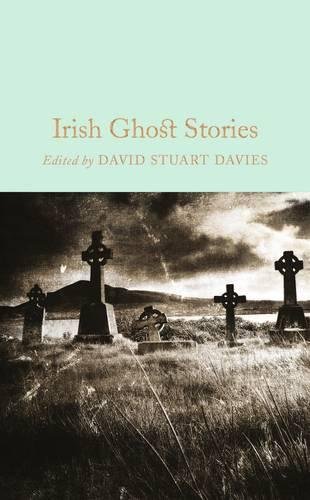 In contrast to this, ‘The Canterville Ghost’ is characterised by Wilde’s trademark wit. It was his first story to be published and this light-hearted tale concerns an American family who buy a large old English house, Canterville Chase. They are subsequently haunted by the ghost of Sir Simon de Canterville, a previous owner. The story highlights cultural misunderstandings between ‘modern’ Americans and the ‘traditional’ English. The Americans’ scepticism leads to hubris as they fail to heed warnings about the haunting. When informed that the ghost ‘always makes its appearance before the death of any member of our family’, the father retorts, ‘so does the family doctor’. It plays on the humorous aspects of hauntings, with a Dowager Duchess terrified by ‘two skeleton hands being placed on her shoulders as she dressed for dinner’. But the sceptical American parents have a practical answer for every problem, offering the ghost lubricating oil for his clanking chains and a tincture for the horrible noises he makes. Our sympathies soon lie more with the ghost than with the family he fails to frighten, especially when the young twins turn the tables on him, ambushing him and shouting ‘Boo!’ in his ears. We are told the ghost’s nerves are completely shattered – a strange plot indeed.
In contrast to this, ‘The Canterville Ghost’ is characterised by Wilde’s trademark wit. It was his first story to be published and this light-hearted tale concerns an American family who buy a large old English house, Canterville Chase. They are subsequently haunted by the ghost of Sir Simon de Canterville, a previous owner. The story highlights cultural misunderstandings between ‘modern’ Americans and the ‘traditional’ English. The Americans’ scepticism leads to hubris as they fail to heed warnings about the haunting. When informed that the ghost ‘always makes its appearance before the death of any member of our family’, the father retorts, ‘so does the family doctor’. It plays on the humorous aspects of hauntings, with a Dowager Duchess terrified by ‘two skeleton hands being placed on her shoulders as she dressed for dinner’. But the sceptical American parents have a practical answer for every problem, offering the ghost lubricating oil for his clanking chains and a tincture for the horrible noises he makes. Our sympathies soon lie more with the ghost than with the family he fails to frighten, especially when the young twins turn the tables on him, ambushing him and shouting ‘Boo!’ in his ears. We are told the ghost’s nerves are completely shattered – a strange plot indeed.
Eventually, the ghost develops a rapport with the daughter Virginia. She helps free him from his ghostly state and he is finally laid to rest, ending the haunting of Canterville Chase. Although ghost stories may appear formulaic, expert writers often manage to introduce elements that are novel and invigorating – Wilde certainly instilled his story with charm, humour and pathos.
Yeats, on the other hand, infused his ‘Hanraham’s Vision’ with poetic language and a sense of place. The setting is Ben Bulben mountain in County Sligo. Here, proximity to nature plays an important role in building atmosphere:
And at last, at the fall of day, he came to the Steep Gap of the Strangers, and there he laid himself down along a ridge of rock, and looked into the valley, that was full of grey mist spreading from mountain to mountain.
The language is simple and evocative. It creates a scene that is both beautiful and forlorn. The protagonist, Hanraham, seems to blend in with the environment as well as being at its mercy. Yeats introduces elements from Irish mythology and history, creating a sense of timelessness that is overpowering. Hanraham’s mystical vision is too much for him to bear and the ending leaves the reader daunted.
J. H. Riddell’s ‘The Old House in Vauxhall Walk’, with its harsh urban setting, could not be more different from Yeats’ offering. A young man from a wealthy background finds himself disinherited and homeless after an argument with his father: he is at the mercy of London at its cruellest. A chance meeting with an acquaintance provides him with the opportunity to stay in an abandoned old house in Lambeth. However, the house is haunted as a result of a murder that took place there. The victim was the sister of the landlord. After witnessing terrifying apparitions that provide insight into the murder, the young man is able to help the landlord, and the gains he makes in the process puts an end to his poverty.
The London setting reminds us of Ireland’s dependence on the city up until the twentieth Century. In fact, many of the writers in this volume had strong links with the British mainland: the poverty of London’s slums was as much a reality as mists descending over Ben Bulben. In Riddell’s story, there is much social commentary that shows the poverty portrayed was as feared as any ghost or apparition, the bleak atmosphere reflecting a society where ‘the greed of the miser eats into the very soul’. The reader is left terrified not just by the supernatural but also by their own potential helplessness in this world. It’s a fear that becomes more acute in times of increased economic uncertainty, much like that which we are living through now.
Fitz-James O’Brien’s offering, ‘What was It?’, further tests our mettle. It is set in New York where many Irish emigrants ended up. It reminds us that the setting for an effective ghost story does not need to be an ancient country pile like Canterville Chase. O’Brien’s setting – a large New York house that was built a couple of decades before the story begins – manages to capture and convey the atmosphere of the New World in a way that feels contemporary. Its owners have problems renting it out because of rumours of a haunting, but eventually it is taken over by a landlady and her band of boarders who are all sceptical about the supernatural. The tale is narrated by one of these lodgers. They consider themselves a forward-thinking lot who are disappointed not to be confronted by anything out of the ordinary. One night, after smoking opium, the narrator is attacked in his bed by an invisible, but very real, creature. He and his companions manage to restrain the creature and tie it up even though they cannot see it. They finally discern its horrific shape by chloroforming it, building a mould around it and making a model. They manage to hold the creature captive and starve it to death with all the horror that this entails. Even though the story was written in the nineteenth century, it still has a modern feel to it, largely dues to its cosmopolitan city setting in the ‘New World’. The characters are sceptical and egotistical. There are references to drug-taking and the use of chloroform. Yet when terror strikes, the façade of this confident world begins to crumble and it is only with the greatest of effort that any semblance of order is restored. Be warned: this story is genuinely terrifying.
The tales collected within Irish Ghost Stories highlight the importance of landscape, the close ties with mainland Britain, the experiences of the emigrant, the horrors of unbridled capitalism, the encroaching of modernity, and the need for poetry and humour when faced with the unknown. Despite not considering myself a patriot, this anthology provokes in me a sense of pride for the Irish ghost story, and reminds me that there is something cathartic about a well-written story where the protagonist is completely transformed as a result of an encounter with a ghostly presence – the most obvious example being Scrooge in Dickens’ ‘A Christmas Carol’. Ultimately, though, it is not about analysis: reading this anthology is about savouring the stories in the dimming light. Enjoy!
~
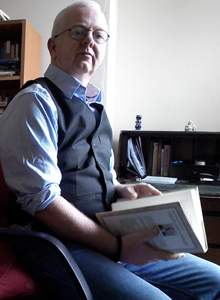 Brendan Joseph O’Dea lives and works in Leicestershire. He is passionate about history, religion, spirituality and literature. He writes fiction and non-fiction in his spare time, an activity he finds very therapeutic. He especially values the short story as a creative medium. He enjoys reading Gothic fiction, crime fiction and biographies.
Brendan Joseph O’Dea lives and works in Leicestershire. He is passionate about history, religion, spirituality and literature. He writes fiction and non-fiction in his spare time, an activity he finds very therapeutic. He especially values the short story as a creative medium. He enjoys reading Gothic fiction, crime fiction and biographies.
